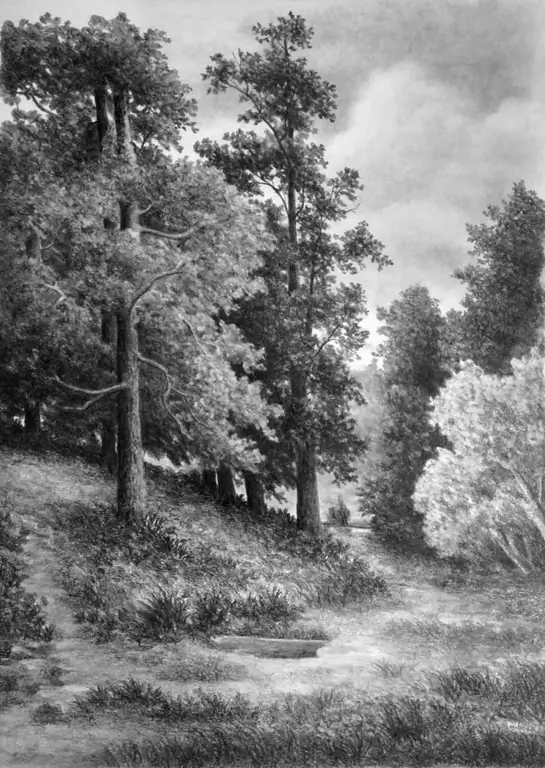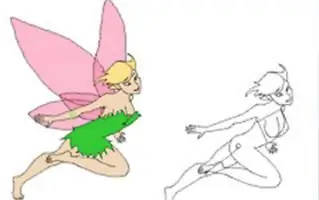2025 Author: Leah Sherlock | [email protected]. Last modified: 2025-06-01 06:56:42
Forest is different: rare or deaf, light deciduous or dark pine, bright summer or bare winter. Each state carries a certain mood, and when drawing a picture, we must understand what feeling we want to convey. In order to start, you don’t need much, and in this article we will analyze how to draw a forest step by step with a pencil. A pencil drawing can be used as a preparatory stage when drawing with paints, or you can make an independent, elaborate work.

Materials
What do you need for this?
- Paper. You can use printed paper or thicker medium-grain paper.
- Sharpened pencils, preferably in different hardness: 2H, HB, 2B, 4B and 6B (full range of pencils: 6H to 8B).
- Eraser.
What you need to know?
Before we draw the forest, we must imaginehimself it. If you are a beginner, it is better to keep a photo, painting or real landscape in front of your eyes.
One of the traditional options is to draw a forest in the middle of which there is a straight or winding path or a river. The same technique is used here as with the rails of the railway going beyond the horizon. It immediately creates a sense of depth.
The forest can be drawn both "outside" - without going into it, and "from the inside". In our example, we will consider the second option.

Make a sketch
First, you need to select the "piece" of the forest that we want to depict, and place it so that it fits into the sheet. To do this, you can make a markup by drawing vertical and horizontal lines along the center of the sides. At the very beginning, when composing a composition, problems may arise, so it is easier to use ready-made options from photographs or paintings.
Easy to mark the horizon line - usually the earth and sky are related as 1 to 3, but sometimes the horizon line can be higher or lower. In the center or to the side, with straight or winding lines, we denote the future path, the two lines of which converge at a point on the horizon line. When drawing, it is important to take into account the principle of perspective reduction - the closer the path is to us, the wider it is, the farther to the horizon, the narrower it becomes.
After we proceed to the trees. We mark their location with straight or curved lines, and also take into account the law of perspective reduction: the farther the trees are from us,the thinner their trunks become, and the outlines more blurred. Also, when removing trees from the foreground, their bases will be slightly higher than the previous ones, they are not recommended to be placed on the same level. Some trees should overlap, just like in nature.
Tree trunks should not be drawn perfectly straight, every tree has natural curves. In order to convey them, you need to outline the "breaking points" with a thin line, connect them, try to recreate the general silhouette of the trunk using them. It's okay if at first it doesn't work out, here you need to "fill" your hand a little. Background trees can be worked out in less detail.
We outline the main, most noticeable and thick branches, as well as the general outlines of the crown. All small branches do not need to be worked out in detail, as well as leaves, it is enough to outline a few in the foreground and some other places to transfer the texture.

Creating volume
First of all, we need to understand where the light comes from (front or back, right or left), outline the shadows on the trunks and on the ground. For example, if the light source is to the right and behind, then the shadows will lie on the left front parts of the tree trunks, that is, on the other side. Then we work on the ground and foliage.
When working with volume, consider three factors:
- Chiaroscuro. It is built from light, penumbra, shadow, reflex and shadow falling on the ground. That is, using the example of a particular tree trunk, we can see that it has the mosta dark place (shadow), next to it is a lighter place (partial shade), and then comes the lightest part (light). A reflex is a reflection of light.
- Hatching. Roughness on watercolor paper helps a lot to convey texture. In principle, you can hatch both vertically and horizontally. The main thing is to remember where to leave unshaded parts (or lighten them with an eraser), where to put lighter and darker shadows.
- Degree of detail. The trees next to us will be more detailed, their shadows will be darker and their highlights will be brighter.
Start shading the trees better from behind, if the light falls from there. If it's the other way around, then forward. We go from light to dark. For dark shades, it is most convenient to use soft pencils, for light ones - either hard or soft with gentle pressure. Gradually work through the whole drawing in this way.

These tips are good to start with, but if you want to take it to the next level, you'll need to work on the details: draw different types of trees, work with light and shade, paint from life to get a better sense of form and find new plans. For inspiration, you can watch (and take) photos, watch how professional masters solve compositional problems, watch lessons, redraw.
We hope that this article gave you the answer to the question of how to draw a forest, and you enjoy the process!
Recommended:
How to draw Santa Claus with a pencil step by step. How to draw Santa Claus on glass

On the eve of the New Year holidays, everyone expects a miracle. Why not create a little magic at home with the kids? Parents will agree that time spent with kids is priceless
Draw pictures: a step-by-step instruction for beginners. How to draw a drawing with a pencil?

You don't have to be a real artist to learn how to draw well. And you don't even need to have special talents. It is important to simply be able to hold pencils / brushes / pens in your hands and master several basic techniques for transferring an image to a plane of paper or any other surface. In essence, you just need to learn how to copy the drawings of others, respecting the proportions and lines of the original
How to draw a cylinder with a pencil with a shadow step by step? Step by step instructions and recommendations

Pencil drawing is very tricky when you want to create volume and draw a shadow. Therefore, consider how to draw a cylinder in detail in different versions
How to draw a sitting dog with a pencil step by step - step by step description and recommendations

It is through creativity that children learn about the world around them. To learn and remember the features of each animal, you need to learn how to depict them correctly. Below is a detailed instruction on how to draw a sitting dog for children and adults
How to draw Baba Yaga with a pencil step by step. How to draw a stupa, house and hut of Baba Yaga

Baba Yaga is perhaps one of the most striking characters in Russian folk tales, even though she is a negative character. A grumpy character, the ability to use witchcraft items and potions, flying in a mortar, a hut on chicken legs - all this makes the character memorable and unique. And although, probably, everyone imagines what kind of old woman this is, not everyone knows how to draw Baba Yaga. That is what we will talk about in this article

